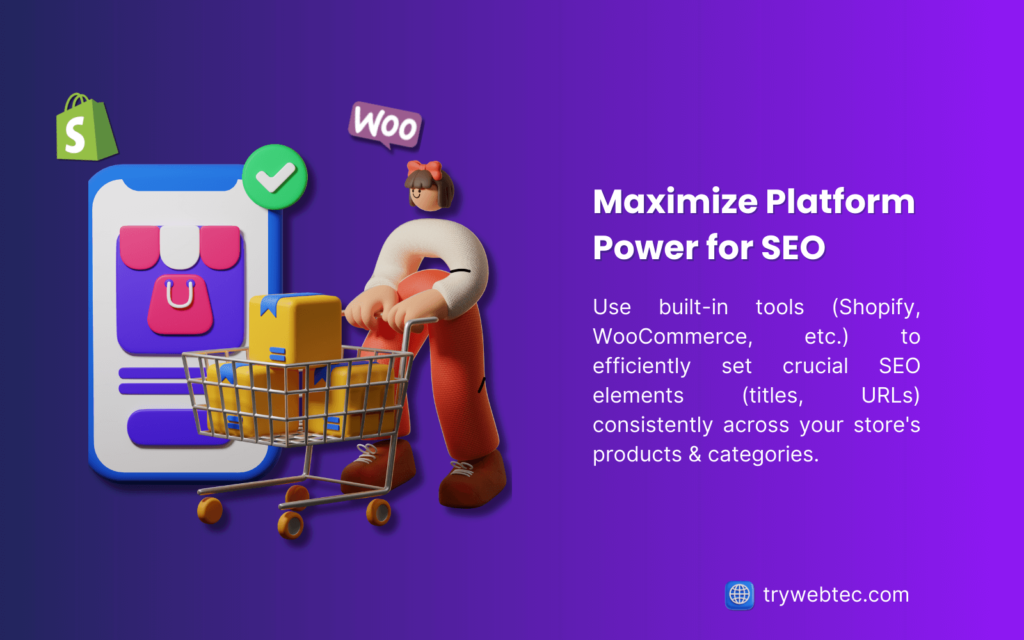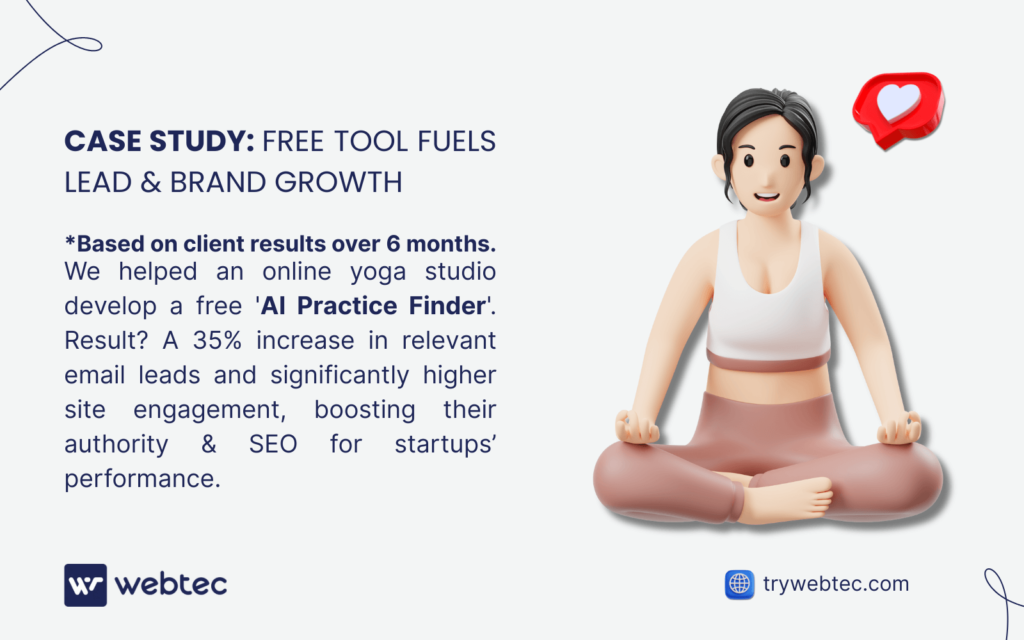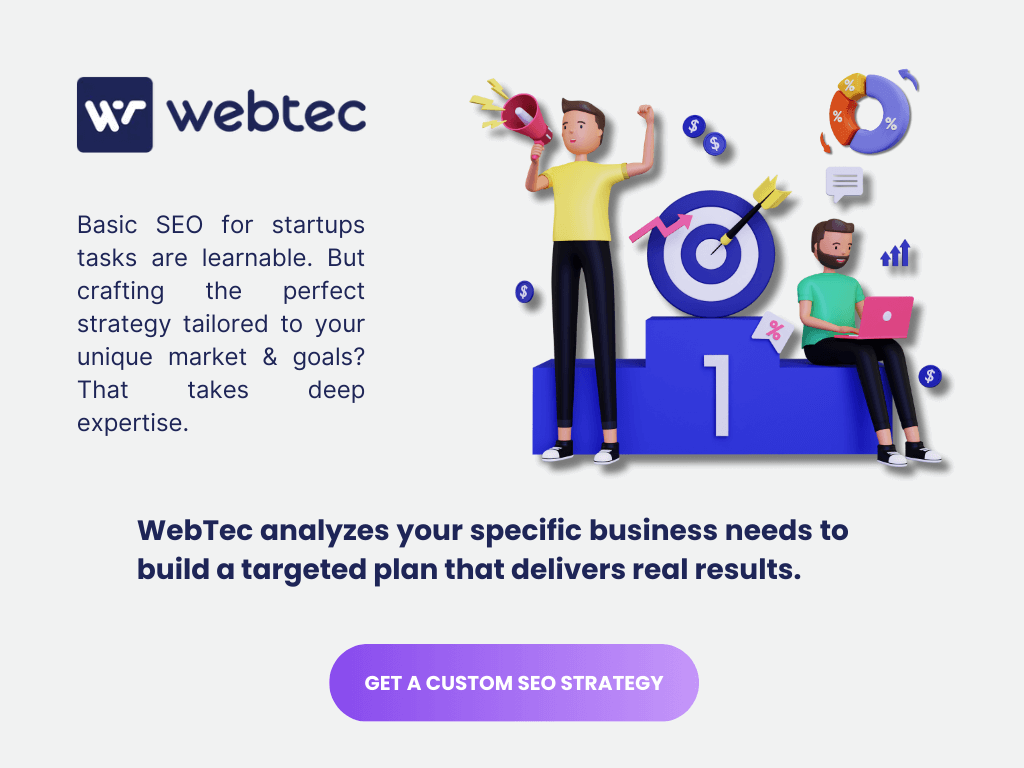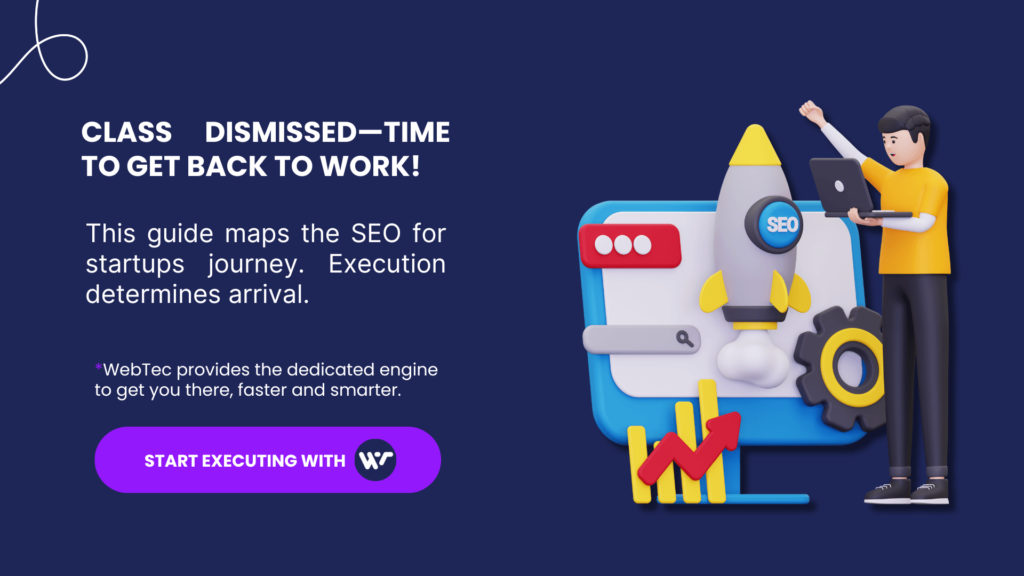Let’s be direct: you’ve probably typed ‘SEO for startups’ into Google before, maybe more than once. And chances are, you were met with a wall of information, overly complicated strategies, or advice so generic it wasn’t actually helpful for your specific situation. It’s frustrating, and frankly, it’s a waste of your valuable time.
Our goal with this guide is entirely different. This is SEO For Startups: The Simplest / Most Definitive Guide on the Internet. No “technical SEO lingo” just for show.
Inside, we’ve laid out clear steps you can actually put into practice because we totally understand that startups are always juggling tight budgets and even tighter schedules.
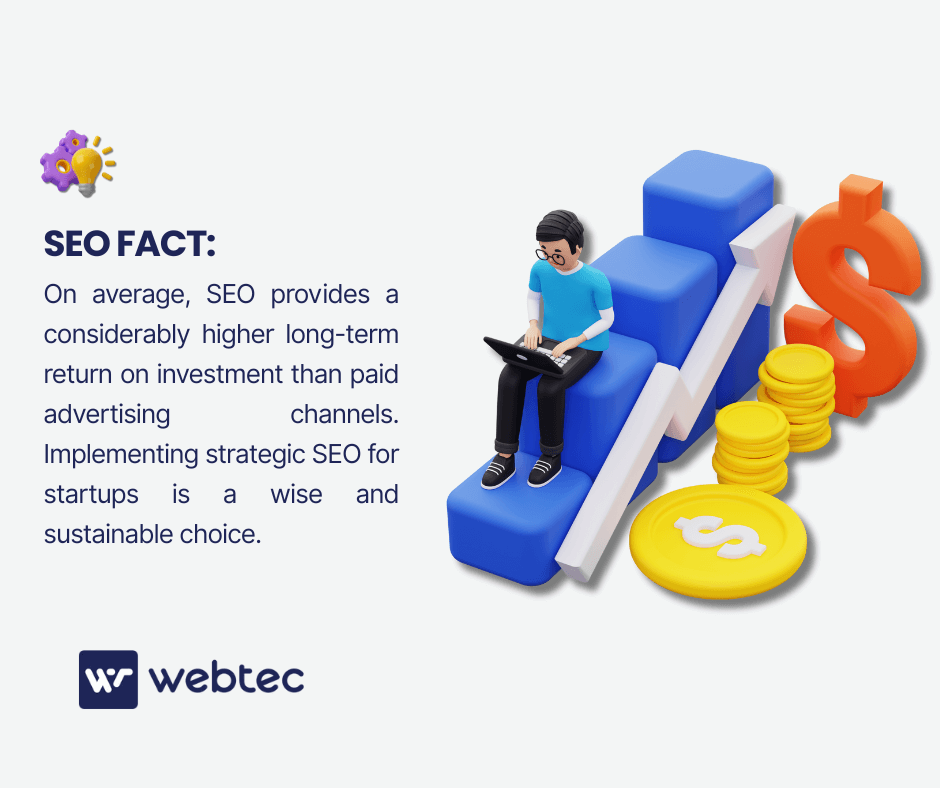
Here’s the plan of this guide: First, we’ll lay down the Core SEO Foundations, the absolute must-dos for any startup website. Get these right, and you’re already ahead of many. Then, we’ll break down specific, practical SEO Action Plans tailored for four common startup models:
- E-commerce Startups
- Service-Based Startups (Online Focus)
- SaaS Startups
- Local Startups (Service or Retail)
We know your time is valuable, so there’s a table of contents on this page. Use it to jump straight to the parts that matter most to your business right now. Consider this your practical, no-nonsense roadmap to getting started with SEO:
I. Core SEO Foundations: Getting the Basics Right (For EVERY Startup Type)
Before getting into strategies specific to your business model, every startup needs a solid SEO foundation. Think of this as guaranteeing your shop is built correctly, easy to find, and welcoming before you start advertising specific products.
At WebTec, we’ve tested & perfected countless approaches, and the most reliable path to sustainable SEO for startup success boils down to these core principles: making your website technically sound, providing genuinely helpful information that answers user questions, and ensuring visitors have a good experience. Get these fundamentals right, and you’re building for the long term.
1. Make Sure Google Can Find and Understand Your Website
Search engines like Google need to be able to access (crawl) and make sense of (index) your website content. If they can’t, nothing else matters. Here are the essential technical checks:
| Check | Why Check This? | Simple Action / Tool |
| Mobile-Friendliness | Many, if not most, users will find you on their phones. Google prioritizes mobile-friendly sites. | Use Google’s Mobile-Friendly Test to see if your pages work well on small screens. |
| Website Speed | Slow sites frustrate users (they leave!) and rank lower. Speed impacts conversions and user experience. | Check your speed with Google’s PageSpeed Insights. It gives scores and suggestions (focus on major issues first). |
| HTTPS Security | Ensures data between the user’s browser and your site is encrypted (secure). Builds trust and is a Google ranking factor. | Look for the padlock icon 🔒 next to your URL in the browser. If it’s missing or shows a warning, you need an SSL certificate (often provided for free by hosting or services). |
| Google Search Console (GSC) | Your direct communication channel with Google. Shows indexing issues, search queries bringing traffic, and more. | Set it up (it’s free!) at Google Search Console. Verify your website ownership. Check it periodically for errors. |
| Google Analytics (GA) | Tracks website visitors: how they find you, what pages they visit, how long they stay. Essential for understanding behavior. | Set up a free Google Analytics account and install the tracking code on your site. Focus initially on basic metrics like Traffic Sources and Top Pages. |
A quick note on website updates: We often hear concerns that changing a website can hurt SEO for startups. This is generally a misconception. Regularly updating your site with valuable content, improving navigation, or fixing bugs actually signals positive activity to Google & other search engines.
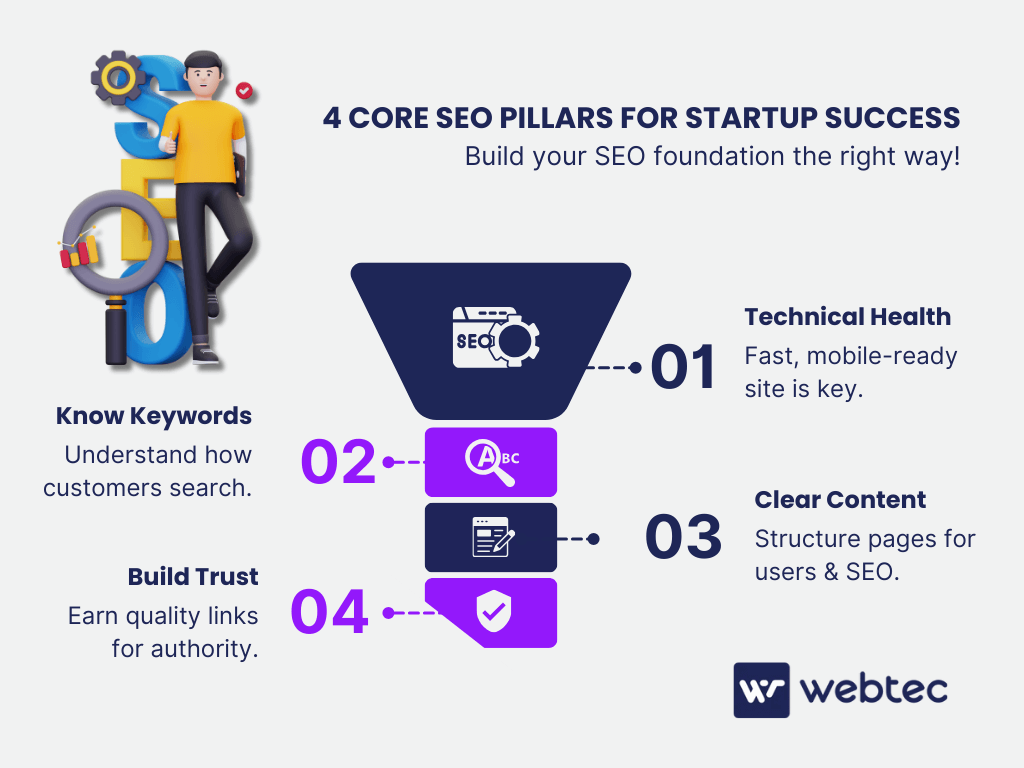
Problems typically only arise from poorly managed updates that introduce technical errors (like broken links or slow speed) or drastically change content without proper redirects. Consistent, thoughtful improvement is good for SEO.
2. Understand What People Search For (Keyword Research Basics)
You can’t be found if you don’t know what people are looking for. Keyword research is about stepping into your potential customers’ shoes.
- Think Like Your Customer: What specific problems does your product or service solve? What words or phrases would they actually type into Google to find a solution like yours? Forget internal jargon; focus on customer language.
- Brainstorm Initial Ideas: Start listing terms related to your core offerings, the problems you solve, and your brand name. Don’t filter too much at this stage.
- Use Simple Tools for Expansion: Type your initial ideas into Google. Look at the Autocomplete suggestions as you type and the “People Also Ask” boxes or “Related Searches” at the bottom of the results page. These are real queries people use.
- Understand Search Intent: This is crucial. Why is someone searching for a particular term?
- Informational: They want to learn something (e.g., “how does SEO work?”).
- Navigational: They want to find a specific website (e.g., “WebTec“).
- Commercial Investigation: They are comparing options before buying (e.g., “best SEO agency for startups“).
- Transactional: They are ready to buy or take action (e.g., “hire SEO agency London”).
Matching your content to the likely intent is key. Don’t try to sell hard on a page targeting someone who just wants information.
3. Content is King, but Clarity is Queen
Your website pages (product descriptions, service explanations, blog posts, the ‘About Us’ page) are your content. This content needs to be clear/simple, helpful, and optimized so both users and search engines understand it.
| Element | What It Is (Simply Put) | Why It Matters | Simple Action |
| Page Title (Title Tag) | The main blue link shown in Google search results. The title of the browser tab. | Tells Google and users the primary topic of the page. Huge impact on click-through rate and ranking. | Write a unique, clear title for each important page (around 50-60 characters). Include your main keyword naturally near the beginning. |
| Headings (H1, H2, etc.) | The visible headlines and subheadlines that structure your page content. | Help users scan the page and understand its structure. Help Google understand the hierarchy of information. | Use one H1 tag per page for the main topic (often similar to the Page Title). Use H2s, H3s, etc., for sub-sections. Include relevant keywords. |
| Meta Description | The short text snippet appears below the blue link in search results. | Acts like ad copy – convinces users to click your link over others. Doesn’t directly impact rankings much. | Write a compelling, unique description for key pages (around 150-160 characters). Include keywords and a call to action if appropriate. |
| Internal Linking | Linking from one page on your website to another relevant page on your own website. | Helps users navigate your site. Spreads “link equity” (ranking power) around your site. Helps Google find pages. | Link related pages together using descriptive anchor text (the clickable words). E.g., link from a blog post about SEO basics to your SEO services page. |
The goal is always to create content for the user first. Make it easy to read, answer their questions thoroughly, and use keywords naturally where they make sense.
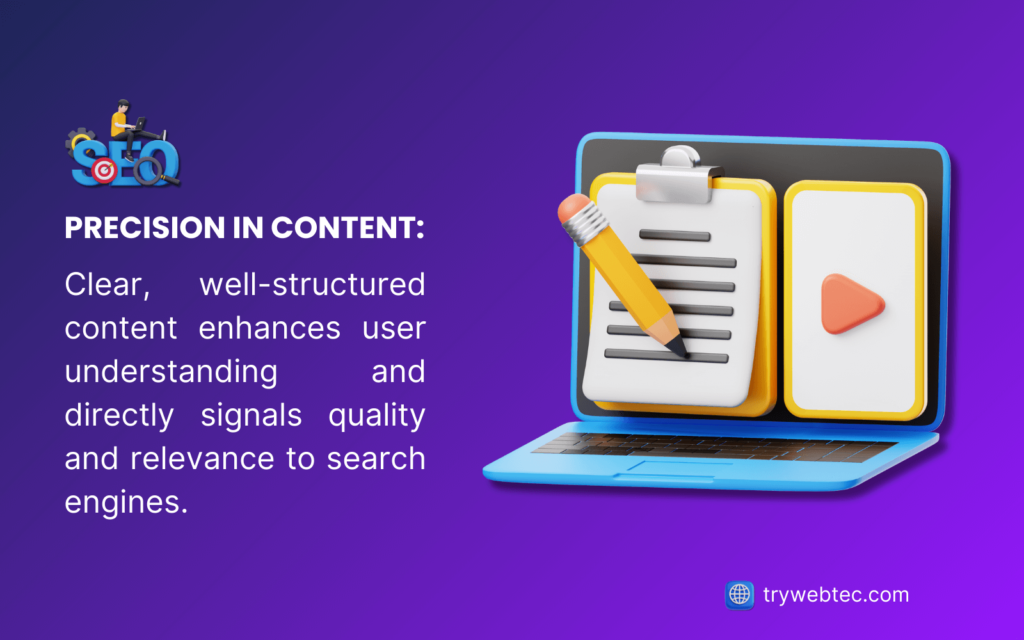
4. Building Trust Signals (Basic Link Principles)
Think of links from other websites to yours (often called backlinks) as votes of confidence or recommendations. Google sees relevant, high-quality links as a sign that your site is trustworthy and authoritative.
- Quality Over Quantity: A few links from relevant, respected websites in your industry are far more valuable than hundreds of links from low-quality or irrelevant sites.
- Focus on Earning Links Naturally: The best way to get good links is often by creating genuinely valuable content (guides, tools, research) that others want to reference, or by building real relationships (partnerships, outreach). We’ll cover specific tactics for different startup types later.
- Crucial Warning: Avoid buying links or engaging in spammy link schemes. These tactics violate Google’s guidelines and can lead to penalties, severely damaging your visibility. Focus on legitimate methods.
Getting these core foundations right sets the stage for more specific SEO efforts. Next, we’ll look at how to apply these principles based on your startup’s business model.
II. Step-by-Step SEO for E-commerce Startups: A Simple Guide
For an online store in any startup phase, effective SEO is your digital salesperson, working 24/7 to connect customers searching online with the products you are selling, developing or testing.
The most direct path to sustainable growth is making your store clear, trustworthy, and incredibly easy for both shoppers and search engines like Google to navigate and understand. This step-by-step plan shows you exactly how to perfect your SEO if you are an E-commerce startup.
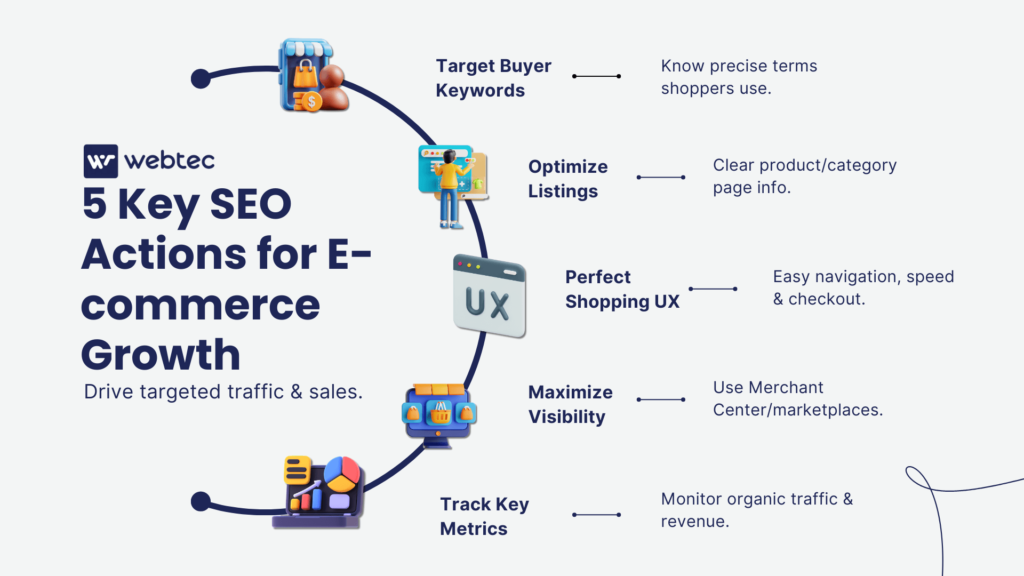
Step 1: Understand How Your Customers Search (Keyword Research)
Before anyone can find your products, you need to know the exact words and phrases they type into Google. Keyword research it’s about stepping into your customer’s shoes and thinking exactly like they do when they’re looking to buy something or solve a problem your product addresses (Even if the keyphrase sometimes seems incorrect). Getting this right is the foundation of smart SEO for startups.
Here’s a breakdown of the common types of search terms (keywords) potential customers might use:
| Keyword Type | What It Is | Examples | Why It Matters for E-commerce |
| Product Specific | Exact or very descriptive terms for a particular item. | “Wooden round coffee table”, “waterproof hiking boots size 9”, “beginner digital photography course” | High chance of leading to a sale (high purchase intent). Targets buyers who know what they want. |
| Category Based | Broader terms describing a group or type of product. | “living room furniture”, “men’s running shoes”, “online marketing courses” | Good for your category pages. Captures shoppers browsing options within a type. |
| Problem/Solution | Terms people use when seeking a fix, not necessarily a product name. | “how to organize a small kitchen”, “best chair for lower back pain”, “easy meal prep ideas” | Attracts customers early in their buying journey. Shows how your product helps. Can be great for blog content linking to products. |
| Long-Tail | Longer, more specific phrases (often 3+ words). | “organic cotton baby onesie newborn blue”, “adjustable standing desk under $300” | Less competition, often higher conversion rates as they are very specific needs. |
- Simple Tip: Start typing your product ideas into Google. Pay attention to the Autocomplete suggestions that appear – these are real searches! Also, look at the “People Also Ask” boxes and “Related Searches” at the bottom of the results page for more ideas straight from Google.
Finally, consider the intent behind the search: Are they just learning (Informational), comparing (Commercial Investigation), or ready to buy (Transactional)? Match your page content to that intent.
Step 2: Optimize Your Digital Storefront (Product & Category Pages)
Think of your product and category pages as your most important sales floor (people have no idea how important these pages are and often overlook them). They need to be crystal clear for customers to understand what you’re selling and persuasive enough for them to buy.
Crucially, they also need to be perfectly clear for search engines so Google knows exactly what each page is about. Simplicity wins here. Avoid confusing jargon or overly technical descriptions.
Here’s how to optimize the key parts of these pages:
| Page Element | Why It’s Crucial for E-commerce SEO | Simple Action & Generic Example |
| Product Title / H1 Tag | The main headline identifying the product for users & Google. | Be clear and descriptive. Use the primary product name + key feature/variant. Ex: “Women’s Trail Running Shoe – Waterproof – Grey/Pink” |
| Product Description | Essential! Explains what it is, who it helps, and key benefits. | Write naturally. Focus on benefits & uses. Use keywords logically. Keep it easy to read. Ex: “Stay dry on the trails with these comfortable, waterproof running shoes. Lightweight design perfect for long distances. Available in sizes 5-11.” (NOT: “Experience unparalleled hydro-kinetic foot resilience…”) |
| High-Quality Images / Videos | Shoppers MUST see the product clearly from multiple angles. | Use clear, well-lit photos/Videos. Show different views, context of use (if applicable). Allow zoom. |
| Image Alt Text | Describes the image if it can’t be seen (accessibility & SEO). | Write a short, descriptive phrase using relevant keywords. Ex: “grey and pink waterproof women’s trail running shoe side view”. |
| Customer Reviews | Builds trust (social proof), adds fresh content, and uses customer language. | Encourage buyers to leave reviews (e.g., follow-up email). Display reviews prominently. Respond to them! |
| Category Page Info | Helps users navigate; organizes products; important SEO hubs. | Group similar products logically. Write a short, helpful intro paragraph for each category page using relevant keywords. Ex: “Browse our selection of durable and comfortable women’s running shoes…” |
| Clear Call-to-Action | Tells the user exactly what to do next (BUY!). | Use obvious, action-oriented buttons. Ex: “Add to Cart”, “Buy Now”, “Choose Size”. Make them stand out visually. |
- Key Principle: Describe your product like you’re explaining it simply and honestly to a friend. If they understand the core benefit quickly, search engines likely will too. This clarity is central to good SEO for startups.
Step 3: Ensure a Smooth Shopping Experience (CRO & Accessibility)
Getting people to your site with SEO is only the start. You need them to buy. Conversion Rate Optimization (CRO) is about making your website easy, intuitive, and trustworthy to use, encouraging visitors to complete their purchase.
Good CRO directly supports good SEO for startups because Google favors sites that offer a positive user experience. Accessibility ensures everyone, including people with disabilities, can use your site.
| CRO / Accessibility Area | Why It Matters for Sales & SEO | Simple Checks / Actions |
| Page Load Speed | Slow pages lose sales and rank lower. Users hate waiting. | Use Google’s PageSpeed Insights. Compress images (use tools like TinyPNG). Minimize complex plugins if possible. |
| Mobile-Friendliness | Most shopping happens on phones. Google ranks mobile sites first. | Test your entire site, especially checkout, on a smartphone. Is it easy to click, read, and buy? Use Google’s Mobile-Friendly Test. |
| Simple Navigation | Can shoppers easily find product categories and use the search bar? | Keep menus logical. Ensure your site search works well. Use breadcrumbs (e.g., Home > Shoes > Running) if you have many categories. |
| Effortless Checkout | Complicated checkout = lost sales (cart abandonment). | Minimize required steps. Offer guest checkout. Provide multiple common payment options (PayPal, cards, etc.). |
| Build Trust | Shoppers need to feel secure buying from a potentially new brand. | Prominently display contact info, return policy. Ensure HTTPS security (padlock icon). Show secure payment badges. |
| Basic Accessibility | Makes your site usable by more people; good practice. | Use clear fonts, good color contrast (avoid light grey text on white). Ensure keyboard navigation works. Use alt text for images. |
Step 4: Leverage Your E-commerce Platform’s Tools
Most popular e-commerce platforms (like Shopify or WordPress with WooCommerce) have built-in features or recommended plugins designed to help with basic SEO tasks. Familiarize yourself with these – they can save you time and effort. Using platform features correctly is smart SEO for startups.
| Platform Example | Common Built-In / Plugin SEO Features | Quick Win Actions |
| Shopify | Fields for Page Title, Meta Description, URL Handle (slug), and Image Alt Text. | Go to Products > [Your Product] or Collections > [Your Category]. Scroll down to “Search engine listing preview”. Edit these fields clearly using keywords. Customize URL handles to be short & descriptive. |
| WordPress (WooCommerce) | SEO Plugins (like Yoast SEO, Rank Math) provide guided fields. | Install a recommended SEO plugin. Use its interface on Product/Category edit screens to easily set SEO Titles, Meta Descriptions, check readability, and manage technical settings like sitemaps. Ensure clean URLs. |
Step 5: Build Trust & Buzz around your brand (Getting Links & Social Signals)
Think of links from other reputable websites to your store (“backlinks”) as votes of confidence. Google sees these as a sign that your store is legitimate and valuable.
Social media activity, while not a direct ranking factor, builds brand awareness, drives traffic, and creates “social signals” that can indirectly support your SEO for startups efforts by getting your name out there.
| Strategy | What It Means | Simple Action Ideas |
| Product Features / Reviews | Getting relevant bloggers, influencers, or websites to talk about your product. | Offer Samples: Reach out (personally, not mass emails, please!) to relevant creators offering a free product for an honest review/feature (article, video, social post). Target those whose audience matches yours. |
| Helpful Content Creation | Making useful resources related to your products that others might link to. | Write a “Buying Guide for [Your Product Type]”, a comparison chart, or “How to Choose…” articles. Share it! Genuine value attracts links naturally over time. |
| Social Media Engagement | Building a community and driving traffic from platforms your audience uses. | Be active where your customers are (Instagram, Pinterest, Facebook, TikTok, etc.). Share product updates, user photos (with permission!), run simple contests. Link back to relevant product/category pages. |
| Supplier/Partner Links | If you resell or partner with other brands, can they link to you? | Check if suppliers have a “Where to Buy” page. Ask complementary businesses if cross-promotion/linking makes sense. |
- Important: Focus on earning links through genuine value and relationships. Avoid buying links or using spammy tactics – these can seriously harm your site’s ranking.
Step 6: Expand Your Reach Beyond Your Website (Merchant Centers & Marketplaces)
While optimizing your own website is crucial, smart SEO for startups in e-commerce also involves increasing your product visibility across the web where potential customers are already shopping or searching.
Getting your products listed on relevant platforms and merchant centers expands your reach significantly and builds brand awareness, which can directly & indirectly boost your main website’s authority and traffic over time.
Here are Some Platforms to Consider:
| Platform Type | Examples | Why It Matters for E-commerce Startups | Simple Action |
| Merchant Centers | Google Merchant Center, Bing Places for Business (includes Merchant Center features) | Essential for appearing in Google Shopping results (including free listings) and Bing Shopping results. Puts your products directly in front of comparison shoppers. | Set up accounts. Submit a product feed (a file with detailed product info: titles, descriptions, prices, images, etc. – your e-commerce platform often helps generate this). Keep the feed accurate and updated. |
| Online Marketplaces | Amazon, Etsy, eBay, niche-specific marketplaces (e.g., Wayfair for home goods, Faire for wholesale) | Access to huge existing customer bases. People often start product searches directly on these platforms. Builds brand visibility even if the sale happens off your site. | Identify marketplaces relevant to your products and audience. Create listings optimized with clear titles, descriptions, and quality images (similar principles to your own site). Follow platform rules carefully. |
| Social Commerce | Instagram Shopping, Facebook Shops, Pinterest Product Pins, TikTok Shops, etc.. | Allows users to discover and sometimes purchase products directly within social media apps they use daily. Leverages your social media presence for sales. | Connect your product catalog (often via your e-commerce platform or Merchant Center feed). Tag products in your posts and stories. Create an engaging shop front on these platforms. |
The Strategic Benefit:
Being present on these platforms does several things:
- Increases Visibility: More places for customers to find your products.
- Builds Brand Awareness: Even if they buy on Amazon, they learn about your brand, potentially searching for you directly later.
- Generates Sales: Provides additional revenue streams.
- Can Drive Website Traffic (Indirectly): While direct links from marketplaces might not always pass strong SEO value (often ‘nofollow’), strong brand visibility encourages direct searches and potentially attracts links to your main site from other sources (blogs mentioning your popular Etsy shop, etc.). Ensure your brand name is clear everywhere.
Think of these platforms as extensions of your digital shelf space. By making your products available and discoverable across multiple relevant channels, you increase the overall awareness and authority of your brand, contributing positively to your long-term SEO for startups’ goals and overall growth. Consistency in branding and product information across all platforms is key.
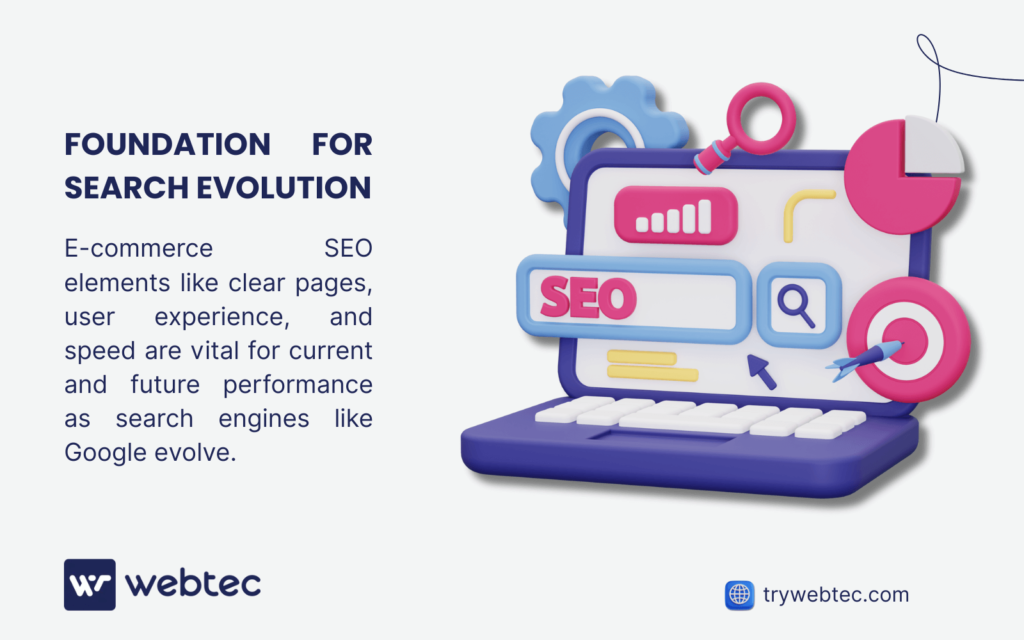
Step 7: Optimize for Modern Search (AI & More)
Google’s search results page (SERP) isn’t just ten blue links anymore. It includes images, shopping results, videos, Q&A boxes (“People Also Ask“), and increasingly, AI-generated summaries (AI Overviews / Google Search Generative Experience – GSE). Optimizing for this modern landscape largely involves the fundamental clarity we’ve already discussed, hint: Section 1 ^^.
| Modern Search Feature | What It Is | How Your Basic E-commerce SEO Helps |
| SERP Features | Images, Videos, Shopping carousels, ‘People Also Ask’ boxes in results. | High-quality product images + descriptive Alt Text helps image search. Clear product info & pricing helps Shopping feeds. Q&A format in descriptions/FAQs can appear in PAA. |
| AI Overviews Google’s (SGE) | AI summarizes information directly at the top of search results. | Clear, factual, concise product descriptions focused on benefits. Well-structured pages using headings (H1, H2). Answering common questions clearly. |
| Voice Search | People asking questions via voice assistants (“Find red running shoes”). | Using natural, conversational language in descriptions. Answering questions directly (e.g., having an FAQ section). Local optimization is key here if applicable. |
| Other Platforms | Product discovery on Pinterest, Instagram, YouTube, etc. | Having optimized profiles/listings on relevant platforms builds brand awareness, which can lead to people searching for your brand directly on Google. |
Essentially, good SEO for startups focused on clear information, quality images, and a great user experience naturally positions you better for these evolving search features.
Step 8: Measure What’s Important (Track Your Success)
You can’t improve what you don’t measure. Tracking key metrics helps you understand if your SEO efforts are actually working and where to focus next. Don’t get lost in vanity metrics; focus on what impacts your bottom line.
| Key E-commerce Metric | Why It Matters | Where to Find It (Usually) |
| Organic Traffic (Product/Category) | How many visitors arrive directly on your key sales pages from free search? | Google Analytics (GA) |
| Organic Conversion Rate | What percentage of those free visitors actually buy something? | GA (E-commerce Tracking required) |
| Keyword Rankings (Key Terms) | Where do you appear in Google when people search for your target terms? | Google Search Console (GSC), SEO Tracking Tools (Paid) |
| Top Organic Landing Pages | Which specific pages are bringing in the most free search traffic? | GA |
| Revenue from Organic Traffic | The ultimate measure: How much money is SEO actually generating? | GA (E-commerce Tracking) |
- Focus on Trends: SEO results build over time. Look for gradual improvements month over month rather than expecting instant jumps. Consistent effort in SEO for startups pays off in the long run.
III. Step-by-Step SEO for Service-Based Startups (Online Focus)
If your startup offers services primarily online – think consulting, digital marketing, coaching, software development, online education – then effective SEO for startups is about becoming a magnet for potential clients actively searching for solutions you provide. Unlike e-commerce, where the goal is a direct product sale, here SEO focuses on building trust, demonstrating expertise, and generating qualified leads (people interested in learning more or hiring you). Let’s break down the simple steps.
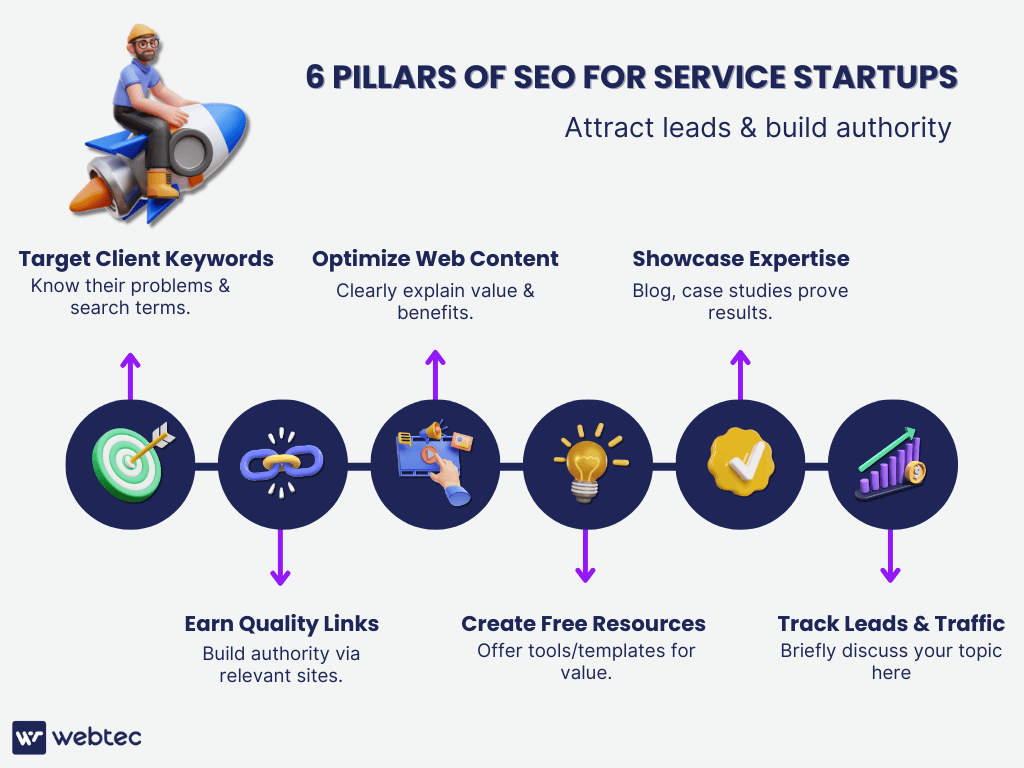
Step 1: Understand How Your Potential Clients Search (Keyword Research)
To connect with people who need your services, you must first understand the language they use when searching online. Don’t just think about your service name; consider the problems you solve and the type of client you best serve. Finding the right keywords is fundamental to attracting the right leads through effective SEO for startups.
| Keyword Type | What It Is | Examples | Why It Matters for Service Businesses |
| Service Specific | Terms describing exactly what you offer. | “business consulting services”, “graphic design agency”, “social media management package” | Attracts people specifically looking for the service you sell. High intent. |
| Problem/Solution | Phrases clients use when they know they have a pain point. | “how to increase website traffic”, “improve employee retention strategies”, “reduce IT costs” | Captures interest early. Positions you as a problem solver. Great for blog content. |
| Audience Focused | Targeting specific industries, roles, or types of businesses. | “marketing services for small businesses”, “leadership coaching for executives”, “web design for therapists” | Narrows down your audience to the most relevant prospects. Speaks directly to their context. |
| Informational | Questions or topics seeking knowledge related to your expertise. | “what is content strategy?”, “benefits of outsourcing HR”, “how does SEO work?” | Builds authority, attracts visitors exploring topics you know well. Establishes you as a thought leader. |
- Simple Tip: Think about the questions clients ask you during initial calls. What challenges do they mention? Use Google’s Autocomplete and “People Also Ask” for real search ideas. Look at the websites of successful competitors – what topics do they cover on their service pages and blogs?
Step 2: Optimize Your Website Content to Build Trust & Convert Visitors
Your website is your virtual handshake and sales pitch rolled into one. It needs to clearly communicate what you do, why it matters (the benefits!), who you help, and what prospects should do next.
Optimizing your content makes it easy for both potential clients and search engines to understand your value proposition. This clarity is essential for service-based SEO for startups.
| Website Content Element | Why It’s Crucial for Service Businesses | Simple Action & Generic Example |
| Clear Service Pages | Explains individual services: what’s included, benefits, process, and ideal client. | Dedicate a page for each core service. Use clear headings. Focus on benefits, not just features. Use relevant keywords naturally. Ex: “Our Social Media Management service helps busy small businesses grow online…” |
| Helpful Blog / Resources | Demonstrates expertise, attracts searches, and answers client questions. | Regularly publish articles, guides, or case study summaries addressing common client pain points or industry questions. Ex: Blog Post: “5 Common Mistakes Businesses Make on Instagram” |
| Case Studies / Portfolio | Shows real-world proof of your success and capabilities. | Detail past projects (get permission!): outline the client’s problem, your solution, and the positive results achieved. Even short summaries add credibility. |
| Testimonials / Reviews | Builds trust through social proof from happy clients. | Feature client quotes (with photo/name/company if possible) prominently on service pages or a dedicated praise page. Ask satisfied clients if they’d provide one. |
| About Us Page | Builds connection, explains your mission/values, introduces your team/expertise. | Tell your story authentically. Explain why you do what you do. Let your personality show (appropriately for your brand). |
| Clear Call-to-Actions (CTAs) | Tells visitors exactly what you want them to do next. | Use action-oriented buttons or links placed logically on pages. Ex: “Request a Free Consultation”, “Download Our Pricing Guide”, “Contact Us Today”, “Learn More”. |
- Key Principle: Focus on clarity and demonstrating value. Answer the client’s core question: “How can this service help me solve my problem?” Make it easy for them to take the next step towards engaging with you.
Step 3: Build Your Authority and Credibility (Getting Relevant Links)
For service businesses, links from other respected websites in your industry act as strong signals of credibility and expertise to search engines. Earning these “backlinks” shows Google that others trust your knowledge and services. Strategic link building is a vital component of successful SEO for startups.
| Link Building Tactic | What It Means | Simple Action Ideas |
| Guest Posting | Writing valuable articles for other relevant websites or blogs read by your audience. | Identify industry blogs or online publications. Pitch a unique, helpful article idea (not a sales pitch!). Include a link back to your site in your author bio. |
| Features / Interviews | Being quoted, interviewed, or featured on industry websites, podcasts, or news outlets. | Position yourself as an expert. Network with industry media contacts. Respond to requests on platforms like HARO (Help A Reporter Out). |
| Partnerships | Collaborating with complementary (non-competing) businesses that serve a similar audience. | Offer mutual referrals, co-host a webinar, and co-create a resource. Partners may link to your website as a trusted resource or collaborator. |
| Creating “Pillar” Content | Developing comprehensive, highly valuable guides or resources on core industry topics. | Create an “Ultimate Guide to X”, a detailed “How-To” resource, or original research. Promote it – genuinely useful content naturally attracts links over time. |
| Niche Directories | Listing your business in reputable, industry-specific online directories. | Find high-quality directories relevant to your service niche (e.g., a directory for certified coaches, marketing agencies, etc.). Ensure consistency. |
- Important: Focus on quality over quantity. One relevant link from a highly respected industry site is worth more than dozens from irrelevant or low-quality sites. Build genuine relationships.
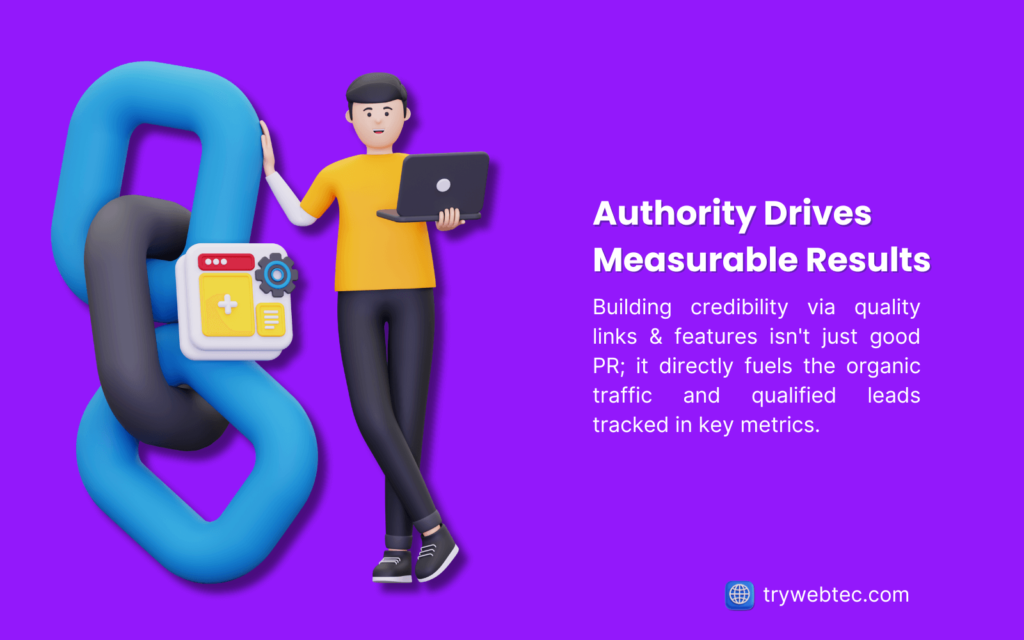
Step 4: Track What Leads to Business (Key Performance Metrics)
To know if your SEO efforts are driving business results, you need to track the right metrics. For service startups, the ultimate goal isn’t just traffic; it’s qualified leads and new clients. Measuring performance helps you understand what’s working and where to focus your limited time and resources.
| Key Service Business Metric | Why It Matters | Where to Find It (Usually) |
| Organic Traffic (Overall & Pages) | How many potential clients find your website & key service pages via free search? | Google Analytics (GA) |
| Lead Generation (from Organic) | The crucial measure: Form fills, quote requests, calls booked, contact inquiries from organic visitors. | GA (Requires Goal / Conversion Tracking setup) |
| Keyword Rankings (Core Terms) | Are you visible when prospects search for the services you offer or problems you solve? | Google Search Console (GSC), SEO Tracking Tools (Paid) |
| Engagement on Content | Are visitors reading your blog posts/resources (Time on Page, Bounce Rate)? Indicates content value. | GA |
| Referral Traffic (from Links) | Visitors arriving directly from the links you’ve earned on other sites. | GA |
- Focus on Trends: Like e-commerce, SEO results for service businesses build gradually. Monitor these metrics over time (month-over-month, quarter-over-quarter) to see the impact of your SEO for startups strategy. Focus especially on the conversion metrics – are more qualified people contacting you because they found you through search? That’s the goal.
Bonus Step 5: Become an Indispensable Resource (Create Free Tools & Value-Adds)
One powerful way to significantly boost your authority, attract high-quality links, and cement yourself as a thought leader is by creating free, genuinely useful resources or simple tools for your target audience. This might sound daunting, but technology (especially AI and no-code/low-code platforms) makes it more accessible than ever, even without a development team. This advanced tactic is a game-changer for ambitious SEO for startups.
Why Create Free Resources/Tools?
- Link Magnet: Genuinely useful tools or unique resources (like calculators, checklists, templates, simple analyzers) naturally attract links from other websites that want to share them with their audience.
- Lead Generation: Offer the tool or resource in exchange for an email address, capturing potential client information.
- Brand Authority: Positions you as an innovative problem-solver and expert in your field, going beyond just talking about solutions to actively providing them.
- Traffic Driver: Can attract significant traffic from people searching for free solutions that the tool provides, capturing users earlier in their journey.
- Enhanced User Engagement & Experience: Providing interactive tools or highly valuable resources keeps visitors on your site longer. This positive engagement (often measured by “dwell time” or time on page) signals to search engines like Google that your page delivers significant value, which can positively influence rankings, while simultaneously offering a superior experience to your visitors.
| Resource/Tool Idea Type | Generic Examples | How AI / No-Code Can Help (Concept) |
| Calculators | ROI calculator for [Your Service], Project budget estimator, Savings calculator | Platforms like Calconic, Outgrow, or even Bubble/Airtable setups can create interactive calculators without complex coding. AI can help brainstorm formulas or logic. |
| Templates | Social media content calendar template, Business proposal template, Project brief template | Offer downloadable files (Google Docs/Sheets, PDFs). AI can rapidly generate draft templates or content ideas for various scenarios. |
| Checklists | Website launch checklist, New client onboarding checklist, Marketing audit checklist | Simple PDFs or interactive checklists using platforms like Typeform or Jotform. AI can help generate comprehensive checklist items based on best practices. |
| Simple Generators/Analyzers | Blog post idea generator, Headline analyzer (basic), Simple report generator | Low-code/no-code platforms (Bubble, Glide, Softr) combined with AI APIs (like OpenAI’s) can power simple tools. Requires some learning but is feasible for motivated non-coders. |
How to Create these types of pages:
You don’t need to be a coding genius! The key is identifying a common, simple calculation, process, or need within your niche that can be automated or simplified.
- Explore No-Code/Low-Code Platforms: Search online for “no-code tools for building [calculators/apps/etc.]”. Many have visual interfaces and templates. Examples include Bubble, Softr, Webflow (for interactions), Zapier/Make (for automation), and Airtable (as a database).
- Leverage AI: Use AI tools like ChatGPT or Claude to brainstorm tool ideas, outline functionality, write descriptive text for the tool’s page, generate template content, or even get basic code snippets or logic guidance for no-code platforms. Search “how to build [tool type] with [no-code platform name]” or “using AI to create [resource type]”.
By investing time in creating even one valuable free resource or tool, you provide immense value upfront, significantly boosting your credibility and making your startup a go-to name in your space – a powerful move for long-term SEO for startup success. Promote it actively once built!
IV. Step-by-Step SEO Action Plan for SaaS Startups
For a SaaS startup, your product is your business. Effective SEO for startups in the SaaS world is absolutely critical for getting discovered by users facing the exact problems your software solves.
It’s about educating potential customers, showcasing your product’s value, differentiating from competitors, and ultimately driving sign-ups, demo requests, or free trials. This isn’t just marketing; it’s essential product discovery.

Step 1: Find the Keywords Your Potential Users Search For
Before users can find your solution, you need to understand what they type into Google when they’re looking for help. Think more of just your brand name. Focus on the pain points your software addresses, specific features users need, comparisons with competitors, and how your tool integrates with others.
Good keyword research forms the bedrock of successful SEO for startups in the competitive SaaS landscape (2023 onwards).
| Keyword Type | What It Is (Simply Put) | Examples (Generic SaaS) | Why It Matters for SaaS |
| Problem/Solution | Terms describing the challenge the user faces. | “how to schedule social media posts”, “track employee hours online”, “automate customer follow up” | Captures users actively seeking a solution, often before they know specific tools exist. |
| Software Category | Broad terms for the type of software you offer. | “project management software”, “email marketing platform”, “customer relationship manager (CRM)” | Attracts users by comparing tools within a known category. Targets mid-funnel users. |
| Feature Specific | Searches for specific functionality or capabilities. | “tool with drag-and-drop editor”, “software with time tracking integration”, “analytics dashboard” | Targets users who know what specific features they need in a solution. |
| Competitor Based | Users are searching for alternatives or comparisons to other known tools. | “[Competitor Name] alternative”, “[Your SaaS] vs [Competitor Name]”, “cheaper than [Competitor]” | Captures users actively evaluating options and already familiar with the market landscape. |
| Integration Based | Searches for tools that connect with software they already use. | “CRM that integrates with Slack”, “project tool syncs with Google Calendar” | Targets users needing solutions that fit seamlessly into their existing workflow. |
| Use Case/Audience | Targeting specific industries, team sizes, or roles the software serves. | “project management for marketing teams”, “CRM for small business owners”, “help desk for e-commerce” | Speaks directly to niche audiences, showing specific relevance and understanding their needs. |
- Simple Tip: Brainstorm the core problems your SaaS solves. Use tools like Google Keyword Planner, Ahrefs, or SEMrush (even free versions offer insights) to find related terms. Look at competitor websites: what keywords are they targeting on their feature pages and blogs? Check online communities (like Reddit or forums) where your target audience discusses their challenges.
Step 2: Optimize Your Website to Educate and Convert
Your website is your primary sales tool. It needs to clearly explain what your software does, who it helps, the key benefits, how specific features work, and why it’s better than alternatives. Your content must cater to users at different stages; from just realizing they have a problem to actively comparing solutions and being ready to sign up. Smart content optimization is vital for SaaS SEO for startups.
| Website Content Element | Why It’s Crucial for SaaS | Simple Action & Generic Example |
| Homepage | Your main intro needs a clear value proposition and direction. | Clearly state what your software does, who it’s for, and the main benefit in the headline. Use primary category keywords. Guide visitors towards key actions (e.g., “Start Free Trial”, “See Features”). |
| Feature Pages | Detail specific capabilities, use cases, and benefits of each major feature. | Create dedicated pages for key features. Use visuals (screenshots, short videos/GIFs). Focus on benefits (saving time, increasing sales), not just the technical function. Optimize for feature keywords. |
| Targeted Landing Pages | Optimized pages for specific campaigns, audiences, or competitor keywords. | Create pages specifically targeting searches like “[Competitor] Alternative” or “[Software Category] for [Industry]”. Keep them focused with a strong Call-to-Action (CTA). |
| Blog Content | Addresses user pain points, provides tutorials, and discusses industry trends. | Regularly publish helpful content: “How to Solve [Problem] with [Your SaaS]”, industry best practices, case studies, tips for maximizing use of your software. Attracts problem-aware users. |
| Comparison Pages | Directly compares your SaaS to key competitors (fairly!). | Create pages like “[Your SaaS] vs [Competitor]”. Objectively highlight differences in features, pricing, and target audience. Focus on your strengths. Target competitor keywords. |
| Use Case / Solution Pages | Shows how your software solves problems for specific industries or roles. | Dedicate pages showing relevance for key target segments (e.g., “How [Your SaaS] Helps Marketing Agencies”). Use segment-specific language and proof points. |
| Pricing Page | Critical decision-making page; often highly visited. | Clearly display pricing tiers, features included in each, and any trial/demo options. Optimize for “[Your SaaS] pricing” terms. Keep it simple and transparent. |
| Clear CTAs | Guide users towards the desired next step (trial, demo, sign-up). | Use prominent, action-oriented buttons throughout the site. Examples: “Start Your Free 14-Day Trial”, “Request a Personalized Demo”, “Sign Up Free”, “View Pricing”. |
- Key Principle: Educate first, sell second. Your website should clearly demonstrate how your software solves a real problem better or more easily than other options. Make the path to trying or buying extremely clear and frictionless.
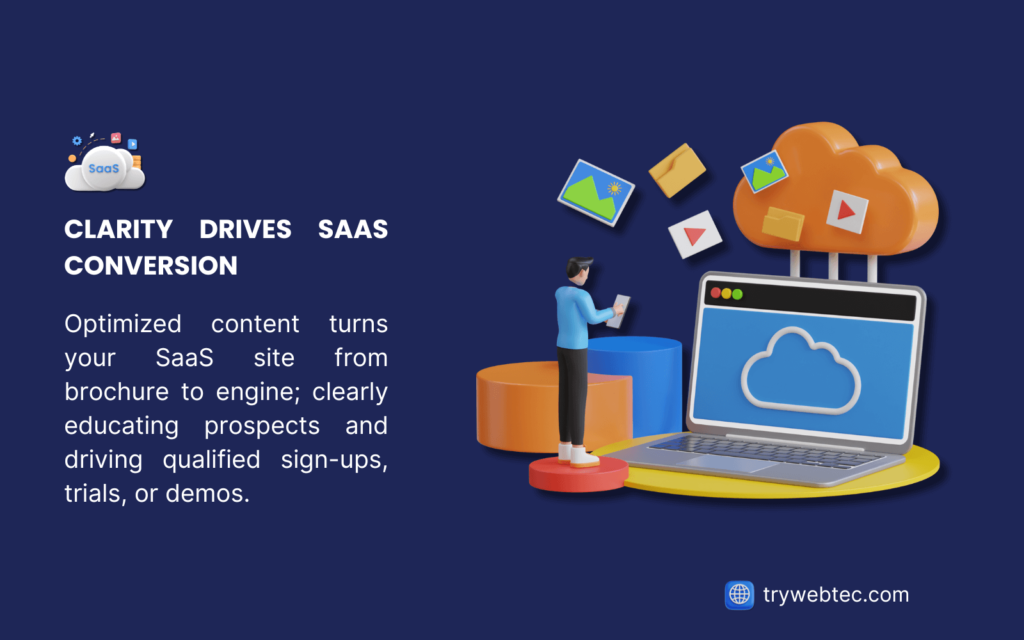
Step 3: Build Authority & Trust Within Your Ecosystem (Link Building)
For SaaS companies, links often come from other tech websites, industry publications, integration partners, and review platforms. These links act as endorsements, signalling to Google that your software is credible, trusted, and relevant within its space.
Building these relationships and earning links is crucial for impactful SEO for startups in SaaS.
| Link Building Tactic | What It Means | Simple Action Ideas |
| Integration Partner Links | Getting listed on the websites of the tools your software integrates with. | Build valuable integrations. Ensure partners list you in their app directory, integrations marketplace, or on a partners page. Provide them with your logo/description. |
| Software Review Sites | Getting listed and encouraging reviews on platforms like G2, Capterra, and TrustRadius. | Claim and complete your profiles accurately. Encourage happy users (especially after positive support interactions or milestones) to leave honest reviews. |
| Guest Posting (Relevant) | Writing valuable articles for tech blogs, industry publications, or partner blogs. | Identify relevant sites that your target users read. Pitch non-promotional, insightful article ideas related to your expertise. Include a link back in your author bio. |
| Free Tools / Resources | Creating calculators, templates, or simple tools related to the problem your SaaS solves. | (See Bonus Step below for details) This attracts links naturally by providing stand-alone value. |
| PR & Media Mentions | Getting featured or mentioned in tech news, industry reports, or online publications. | Announce significant milestones (funding, major product updates, key hires). Build relationships with relevant journalists and bloggers. Offer expert commentary. |
| Niche Directories/Lists | Appearing in curated lists or directories specific to your software category or industry. | Find reputable “Best [Software Category] Tools” lists or industry-specific directories and try to get included (often requires a quality product and outreach). |
- Very Important: Focus on earning links from relevant and reputable sources. Quality trumps quantity every time! Genuine value exchange (integrations, great content) is key.
Step 4: Create Stand-Alone Value (Free Tools & Resources)
One powerful way SaaS startups can accelerate authority and attract valuable links is by creating free tools, templates, or resources that provide genuine utility related to the problem space they operate in. This demonstrates expertise, acts as a lead magnet, and creates assets that others naturally want to share, significantly boosting SEO for Saas startups.
Why Create Free Resources/Tools for SaaS?
- Link Magnet: Highly useful free tools are prime candidates for links from industry blogs, resource pages, and educational sites.
- Lead Generation: Offer the tool/resource access in exchange for an email, building your marketing list with relevant leads.
- Brand Authority: Establishes your company as a helpful expert and innovator, not just a software vendor.
- Traffic Driver: Attracts users searching for free solutions, potentially warming them up to your paid product.
- Enhanced User Engagement & Experience: Interactive tools keep users on your site longer. This positive engagement signals value to Google (potentially influencing rankings) and creates goodwill with potential customers.
| Resource/Tool Idea Type | Generic SaaS Examples | Notes on Creation |
| Simple Calculators | ROI Calculator for using [Software Type], Time Savings Estimator, Pricing Comparison Calculator | It can often be built using specific calculator platforms, spreadsheet embeds, or basic web development. Focus on simple, common calculations. |
| Templates / Worksheets | Project plan template, Content calendar spreadsheet, Email sequence examples, Onboarding checklist | Easily created as downloadable files (Docs, Sheets, PDFs). Offer versions tailored to different use cases that your main software supports. |
| Checklists | Feature comparison checklist, Migration checklist, Compliance checklist | Simple downloadable PDFs or interactive web pages. Great for helping users evaluate solutions or prepare for implementation. |
| Free Limited Version/Tool | Offer a basic, free-forever tier of your main product, OR a separate, simpler free tool solving one specific, small problem. | More complex to build but highly effective. Acts as a direct funnel into your paid product. Needs clear differentiation from paid tiers. |
- Think: What simple, repeatable task or calculation could we help our target audience with outside of our core paid product? Providing this value upfront builds immense trust.
Bonus Step 5: Track What Drives Growth (Key SaaS Metrics)
For SaaS, SEO success is measured by its contribution to user acquisition and revenue growth. Tracking the right metrics shows if your efforts are attracting the right users and converting them into trial users, demo requests, or paying customers.
| Key SaaS Metric | Why It Matters | Where to Find It (Usually) |
| Organic Traffic (Key Pages) | Visitors find your homepage, feature pages, pricing page, and blog via free search. | Google Analytics (GA) |
| Organic Sign-ups / Demo Requests / Trial Starts | The core goal: conversions driven directly by SEO traffic. | GA (Requires Goal / Conversion Tracking setup) |
| Keyword Rankings (Relevant Terms) | Visibility for problem, solution, feature, competitor, and brand keywords. | Google Search Console (GSC), SEO Tracking Tools (Paid) |
| Blog Traffic & Engagement | Measures top-of-funnel attraction and content marketing success. | GA |
| Organic Conversion Rate (%) | Percentage of organic visitors who complete a key goal (sign-up, demo). | GA (Calculated from Traffic & Conversions) |
| Brand vs. Non-Brand Traffic | Shows how much traffic comes from people already knowing your brand vs. discovery. | GSC / GA |
| Lead Quality (if applicable) | Are organic leads turning into qualified opportunities or paying customers? | CRM data linked with the website source |
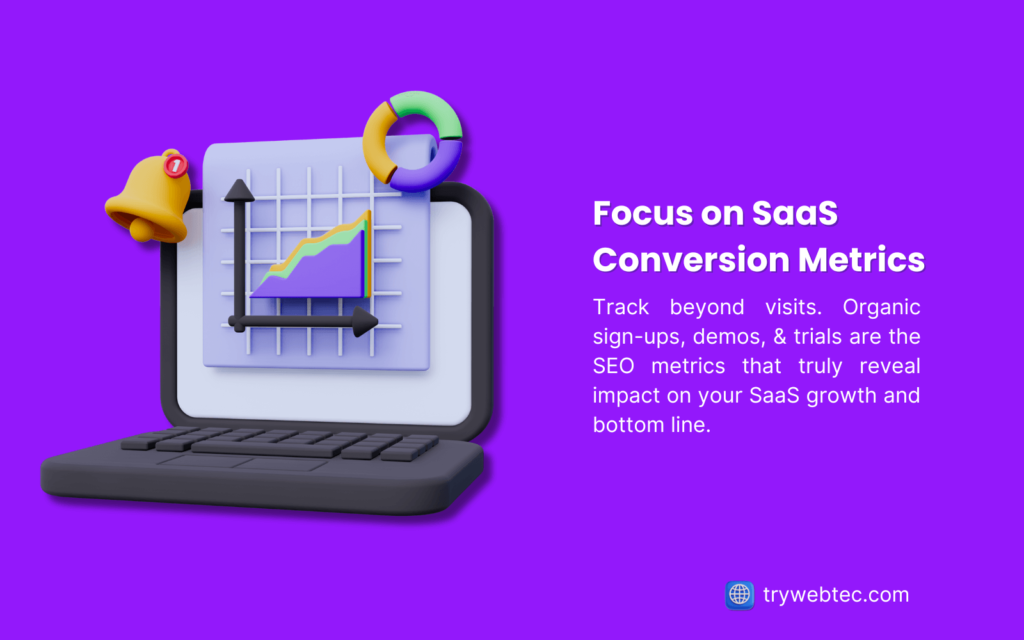
Focus on Trends: SaaS sales cycles can be longer. Look at trends over months and quarters. Is organic consistently contributing more qualified leads and sign-ups? Are you becoming more visible for non-brand, problem/solution keywords? That’s the sign your SEO for startups strategy is maturing effectively.
V. Step-by-Step Local SEO Action Plan for Startups (Service or Retail)
If your startup serves customers in a specific geographic area (whether you’re a restaurant, plumber, dentist, retail shop, or local consultant), then Local SEO for Startups isn’t just important, it’s essential. It’s how nearby customers find you when they search online, often with immediate intent (“pizza near me,” “emergency plumber [City]”).
Your goal is high visibility right in your community’s search results, especially on Google Maps and the “Local Pack” (the map results showing 3 businesses).
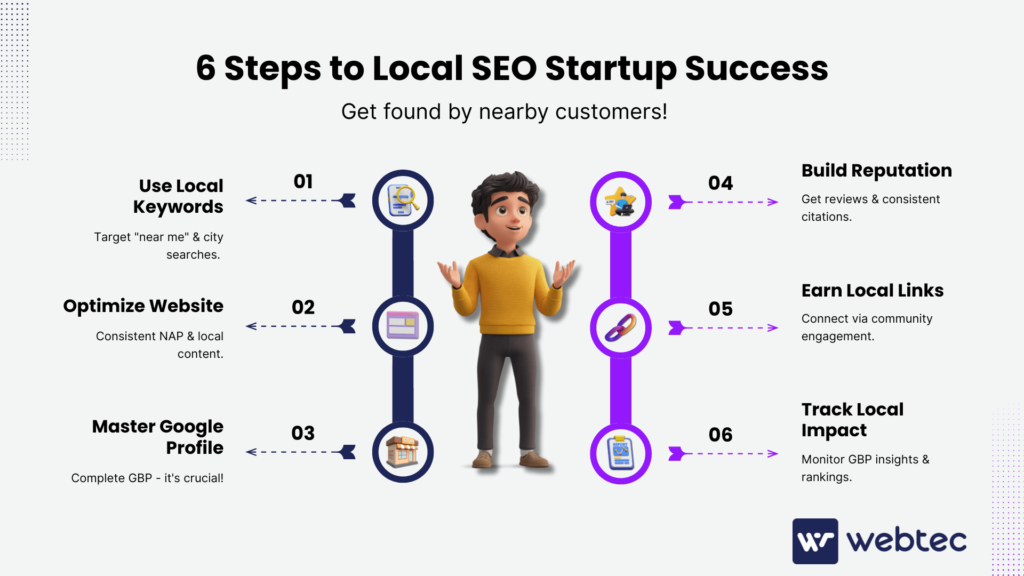
Step 1: Understand What Your Local Customers Search For (Keyword Research)
Local search is all about proximity and immediacy. You need to know the terms people use when looking for businesses like yours, right where they are. Combine your service/product with location terms.
| Keyword Type | What It Is (Simply Put) | Examples (Generic Local) | Why It Matters for Local Businesses |
| Service/Product + Geo | The core local search: What you offer + where you offer it. | “Italian restaurant downtown [City]”, “best coffee shop [Neighborhood]”, “tax advisor [Town]” | Captures users specifically looking for your offering in your service area. |
| “Near Me” Searches | Very common mobile searches; Google uses the searcher’s current location. | “hardware store near me”, “urgent care near me”, “bookstore open near me” | Critical for capturing mobile users looking for immediate options nearby. |
| Local Problem/Need | Searches related to specific needs or occasions within a local context. | “weekend brunch spots [City]”, “same-day gift delivery [Area]”, “fix leaky faucet [Zip Code]” | Targets users with specific, often urgent, local requirements. |
| Category + Geo | Broader searches for types of businesses within a location. | “boutique shops [Main Street Area]”, “family doctors in [County]”, “pet groomers [City]” | Attracts users exploring options within a category in a specific place. |
- Simple Tip: Think like someone who just moved to town or needs something right now. What would they type into their phone? Use Google Maps search and see what auto-suggests. Pay attention to what competitors nearby seem to be emphasizing.
Step 2: Optimize Your Website as Your Local Hub
Your website needs to clearly signal to both users and search engines exactly who you are, where you are, and what you offer locally. Consistency is key here for effective Local SEO for Startups.
| Website Element | Why It’s Crucial for Local SEO | Simple Action & Generic Example |
| NAP (Name, Address, and Phone number) Consistency | Vital! Your Business Name, Address, and Phone number MUST be identical everywhere online. | Include your accurate NAP on your website footer on every page and on your Contact Us page. Use the exact same format as your Google Business Profile. |
| Location Pages (If Needed) | If you have multiple physical locations or serve distinct named areas. | Create a dedicated page for each location/area. Include unique content about that specific spot, its NAP, opening hours, a local map, and area-specific testimonials. |
| Embedded Google Map | Visually confirms your location for users; reinforces location signal for Google. | Embed an interactive Google Map showing your business location, typically on the Contact Us or location pages. |
| Local Keywords in Content | Integrate location terms naturally into your website copy. | Mention your city, neighborhood, or service area on your homepage, service descriptions, and About page where relevant. Ex: “Proudly serving the [Neighborhood] community…” |
| Local Testimonials/Reviews | Shows proof of happy local customers; adds local relevance. | Feature reviews specifically mentioning your location or service area. Ex: Quote: “‘Best plumber in [City]!’ – Jane D.” |
- Key Principle: Make it blindingly obvious to anyone (and any search engine) visiting your site where you operate and how to contact or find you.
Step 3: Master Your Google Business Profile (GBP) – Your Digital Front Door
Your Google Business Profile (formerly Google My Business or GMB) is arguably the single most important element of Local SEO for Startups. It’s the free listing that appears in Google Search (the Local Pack) and Google Maps and is often the first impression potential customers have of your business.
| GBP Optimization Area | Why It’s Non-Negotiable | Simple Actions – Do Them All! |
| Claim & Verify | Ensures you control your listing and prevents hijacking. | Go to google.com/business, find or create your listing, and complete the verification process (usually via postcard, phone, or email). |
| Complete EVERY Section | Provides Google & users with comprehensive info; influences ranking. | Fill out your business name (exactly!), categories (choose the most specific primary one), address, phone, website, hours (keep updated!), services/products, attributes (Wi-Fi, accessibility, etc.), and a compelling description. |
| Add High-Quality Photos/Videos | Showcases your business visually, builds trust, and increases engagement. | Upload clear photos of your storefront, interior, products, team, and happy customers (with permission!). Add your logo and cover photo. Regularly add new visuals. |
| Utilize Google Posts | Share updates, offers, and events directly on your profile; keep it fresh. | Regularly create short Posts about specials, new products/services, events, or blog updates. They expire, so keep posting! |
| Answer Questions (Q&A) | Proactively address common queries; prevents misinformation. | Monitor the Q&A section. Answer questions promptly and accurately yourself. You can even pre-populate it by asking and answering common questions. |
| RESPOND TO ALL REVIEWS | Crucial for reputation! Shows you engage and care; influences rankings. | Monitor reviews closely. Thank positive reviewers. Address negative reviews professionally and empathetically – offer to take the conversation offline. Respond promptly. |
Think of your GBP as a mini-website directly on Google. Keep it accurate, active, and engaging!

Step 4: Build Your Local Reputation Online (Citations & Reviews Beyond GBP)
Beyond Google, your online reputation across other local directories and review sites matters. “Citations” are online mentions of your business NAP. Consistency is very important here!!
| Reputation Building Area | Why It Matters | Simple Actions |
| Local Citations | Listings on directories (Yelp, Foursquare, industry sites) validate your business info for Google. | Identify relevant local and industry-specific directories. Manually create listings OR use a service (like Moz Local, BrightLocal – often paid). Ensure NAP is IDENTICAL everywhere. |
| Encourage Reviews | Reviews build trust, influence buying decisions, and impact local rankings. | Actively ask satisfied customers to leave a review (on Google primarily, but also Yelp or relevant niche sites). Make it easy – provide a direct link. Don’t incentivize reviews inappropriately. |
| Monitor & Respond | Shows you’re engaged and value feedback across platforms. | Regularly check major review sites where your business is listed. Respond professionally to all reviews, just like on GBP. |
- Key Principle: Control your business information consistency across the web and proactively manage your online reputation. Happy local customers are your best marketing asset.
Step 5: Get Involved & Earn Local Links (Community Buzz)
Links from other local websites (businesses, organizations, news) act as strong local relevance signals to Google. Think about how your startup can become part of the local fabric. This aspect of Local SEO for Startups is about real-world engagement leading to online visibility.
| Local Link Building / Buzz Tactic | What It Means | Creative But Straightforward Action Ideas |
| Local Sponsorships | Supporting local events, teams, and charities often yields a link from their site. | Sponsor a Little League team, a school event, or a local festival. Ensure your sponsorship includes a website link on their “Sponsors” page. |
| Community Involvement | Participating in local business groups or community initiatives. | Join the Chamber of Commerce, local neighborhood association, or Business Network International (BNI) chapter. These often have member directories with links. |
| Local Partnerships | Collaborating with nearby, non-competing businesses. | Partner with a complementary business for a cross-promotion (e.g., cafe partners with bookstore for a discount). Offer to link to each other as local resources. |
| Local News / Blog Features | Getting mentioned in local media outlets or community blogs. | Host a unique grand opening event? Offering something novel? Partnering for a charity drive? Alert local news outlets or influential community bloggers. Create a simple press kit. |
| Host Local Events/Workshops | Offer value to the community directly; can generate local buzz & mentions. | Host a free workshop related to your expertise, a customer appreciation event, or a “meet the owner” coffee morning. Promote it locally online – event calendars may link back. |
- Always ask yourself: How can we genuinely connect with and contribute to our local community in a way that also raises our business profile? Real-world relationships often translate into valuable online signals.
Step 6: Track Your Local Impact (Key Metrics)
Measuring success for Local SEO for Startups involves tracking metrics that show visibility within your geographic area and actions taken by local customers.
| Key Local Metric | Why It Matters | Where to Find It (Usually) |
| GBP Insights Performance | Direct impact: Calls, Website Clicks, Direction Requests originating from your GBP listing. | Google Business Profile Insights |
| Local Keyword Rankings | Are you visible in Search & Maps for “[service] in [city]” or “near me” terms? | Google Search Console (GSC), SEO Tracking Tools (Set for local area) |
| Traffic to Local Pages | Visitors landing on your website’s specific location or service area pages. | Google Analytics (GA) |
| Local Pack / Map Visibility | How often and where you appear in the map-based results on Google Search. | SEO Tracking Tools / Manual Checks |
| Review Quantity & Rating Trend | Are you consistently getting more positive reviews across platforms? | GBP, Yelp, other relevant review sites |
| Citation Consistency Score | How accurate and consistent is your NAP across major directories? | Citation Management Tools (Optional – Moz Local, BrightLocal etc.) |
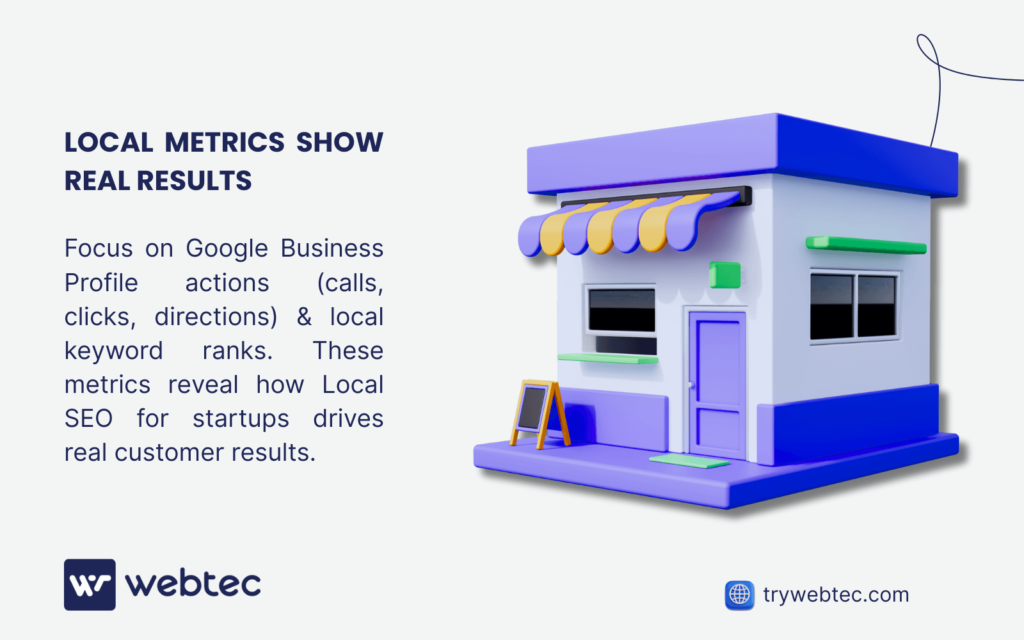
- Focus on Trends: Watch how your GBP (Google Business Profile) interactions grow. Are you ranking higher for core local terms? Are more positive reviews coming in? These trends indicate your local visibility and reputation are improving, directly impacting your startup’s connection with its community.
VI. SEO for Startups Strategy: Commitment, Clarity with Continuous Improvement
1. SEO Requires Sustained Effort and Strategic Patience
These actionable steps get you started, but building strong SEO for startups is a continuous process, not a one-time project. It must be clearly understood that significant SEO results are rarely immediate. Building organic visibility is a strategic investment requiring consistent application over time.
Rather than expecting overnight success, focus should be placed on making steady, incremental improvements. Each optimized page, valuable piece of content created, or positive review earned contributes to cumulative momentum.
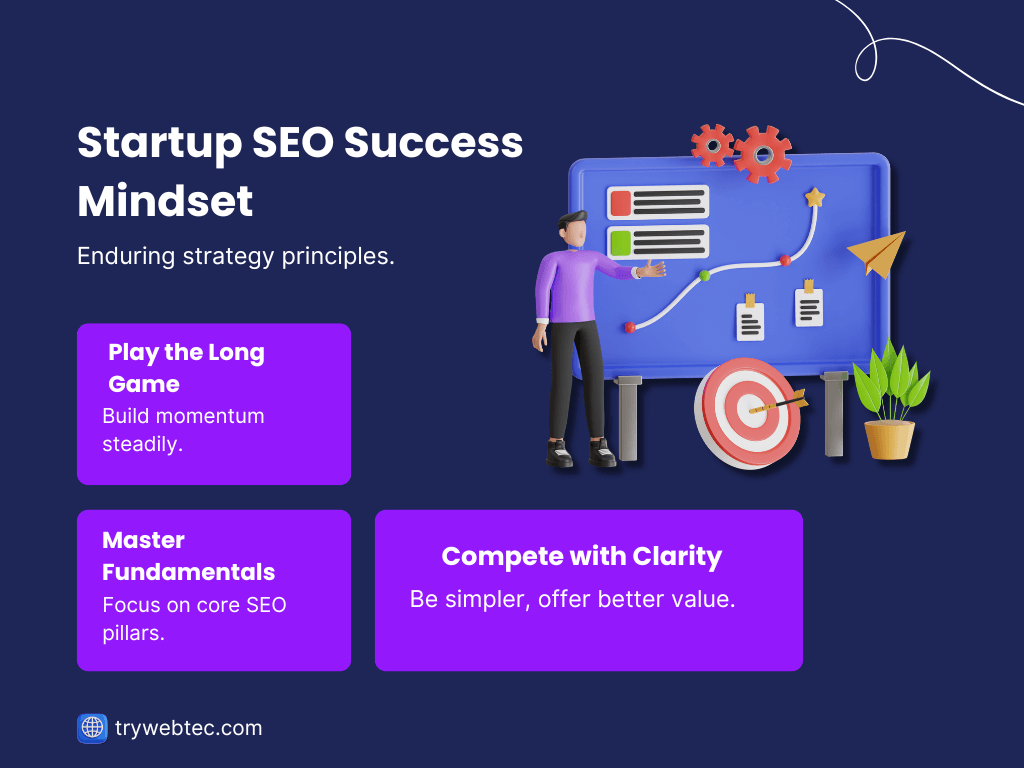
You’ll likely see the tangible benefits of SEO, such as increased traffic, leads, or sales, build up over several months, underscoring the need for a long-term commitment.
2. Always Navigate the Competitive Landscape with Clarity
Success with SEO for startups means recognizing you’re in a competitive space. Staying visible involves more than following a simple list, especially since your competitors are also fighting for that same online customer base.
Therefore, sustainable success hinges on genuinely offering superior value and a better user experience. Continuous improvement of your core product or service is essential, alongside a commitment to describing your offerings with exceptional clarity and simplicity.
When potential customers easily understand your value proposition, and this is reflected in a quality offering, your business aligns well with the search engines’ goal of providing the best results, making effective SEO for startups a more natural outcome.
3. Prioritize Core SEO Principles
The digital marketing landscape, including SEO, is subject to ongoing evolution. Algorithm updates occur, and new search features are introduced. While staying informed is beneficial, allowing constant changes to cause overwhelm or dictate strategy reactively is counterproductive.
Priority should be given to mastering the fundamental principles discussed: maintaining a technically sound website, deeply understanding user intent and search behavior, consistently creating valuable and clear content, building trust and authority, and ensuring a positive overall user experience.
These core elements provide a stable foundation for lasting SEO success, largely insulating your efforts from minor algorithmic fluctuations.
Mastering even these fundamentals, however, requires dedicated time, analysis, and consistent execution/resources that are often constrained within a busy startup environment. This naturally leads to considerations about capacity and expertise…
VII. Need Expertise or More Time? We Can Definitely Help.
1. Bridging the Gap Between Knowing and Doing
You understand the power of a strong digital presence and SEO for startups. This guide gives you the “what” and “why.” But finding the hours and developing the deep expertise to consistently execute these strategies while running your business? That’s the real challenge for lean startups. Time spent wrestling with SEO details is time not spent on your core product or customers.
2. WebTec: Your Dedicated Partner for Web & SEO Success
That’s where WebTec comes in. Since 2017, we’ve focused on making effective & CRO Ready web design and SEO straightforward for busy leaders like you in the US, the EU, and the UK.
We will be your dedicated web and SEO specialists. Our team (experts in SEO, Design, and Development) works together seamlessly, treating your business growth as our primary mission.
We’ve helped startups across diverse fields, from Space & Defense to local farms, E-commerce shops, SaaS companies, and much more, achieve real results. We understand the need to be agile and results-focused.
3. Targeted Solutions for Staying Ahead
SEO for startups is about consistently outperforming competitors. We help you do just that with:
- Growth-Focused Websites:
-
-
- See Before You Commit: Often starting with a free demo redesign.
- Built to Convert: Using data-driven design for maximum ROI.
- Fast & Efficient: Streamlined process (typically ~45 days), easy-to-edit results.
-
- Intelligent “Smart SEO”:
-
- Focus on Impact: We prioritize tasks that actually move the needle for sustainable growth. This means combining big-agency strategic thinking with startup-friendly efficiency.
- Core Fundamentals Mastered: We obsess over crucial technicals like lightning-fast page speed, flawless mobile usability, and sharp meta descriptions that grab clicks.
- Measurable Results: Our goal is clear: elevate your visibility, position you as a leader, and drive a steady stream of qualified leads or customers. We show proof, like boosting client traffic significantly, and often offer a free SEO trial or analysis using real data.
4. Ready to Gain Your Competitive Edge Online?
If you know SEO for startups is vital but lack the time or in-house expertise to constantly optimize and stay ahead of the competition, WebTec is built for you. Let our dedicated team handle the web and SEO complexities so you can focus entirely on leading and growing your business.
- Discover our approach: Strategic SEO Services
- View our impact: Projects we worked on.
- Start the conversation: Contact Us Today
VIII. Conclusion: Take Control of Your Startup’s SEO
We hope this guide cuts through the noise and gives you a practical understanding of how SEO for startups really works. It’s not about secret tricks; it’s about clear communication, understanding your customer, and consistent effort.
Core Principles for Startup SEO Success:
- Know Your Customer’s Search: Speak their language, solve their problems.
- Clarity Converts: Simple descriptions sell better and rank better. Make your value obvious.
- Nail the Fundamentals: Fast site, mobile-friendly design, accurate local listings (like GBP), optimized platform settings – these aren’t optional.
- Build Real Trust: Reviews, helpful content, and genuine connections signal credibility.
- Consistency Wins: Small, regular SEO actions compound over time. It’s a marathon.
- Stay Competitive: SEO is ongoing improvement, not a one-off task. Your rivals aren’t waiting.
Executing this consistently while scaling a startup is tough. You need results, but your time is best spent on your product, your team, and your customers – not deep-diving into SEO complexities or trying to keep up with constant algorithm changes and competitor moves.
This is the gap WebTec fills. We deliver expert web design and focused SEO for startups without the typical agency overhead or jargon. Our team gets straight to the point, implementing proven strategies & business-specific optimisation that drive visibility, attract qualified leads, and grow your customer base.
We handle the technical execution, the content optimization, and the competitive vigilance so you see tangible results while you focus on building your business. We’ve done this successfully across countless industries, adapting to specific challenges and delivering measurable growth.
If you need expert execution to ensure your SEO delivers real business value without consuming your own limited bandwidth, WebTec is ready to act.
Contact Us Today to discuss how we can directly impact your startup’s growth online.

